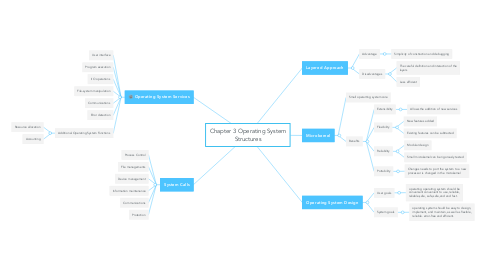
1. Operating System Services
1.1. User interface
1.2. Program execution
1.3. I/O operations
1.4. File-system manipulation
1.5. Communications
1.6. Error detection
1.7. Additional Operating System Functions
1.7.1. Resource allocation
1.7.2. Accounting
2. System Calls
2.1. Process Control
2.2. File managements
2.3. Device management
2.4. Information maintenance
2.5. Communications
2.6. Protection
3. Layered Approach
3.1. Advantage
3.1.1. Simplicity of construction and debugging
3.2. Disadvantages
3.2.1. The careful definition and interaction of the layers
3.2.2. Less efficient
4. Microkernel
4.1. Small operarting system core
4.2. Benefits
4.2.1. Extensibility
4.2.1.1. Allows the addition of new services
4.2.2. Flexibility
4.2.2.1. New features added
4.2.2.2. Existing features can be subtracted
4.2.3. Reliability
4.2.3.1. Modular design
4.2.3.2. Small microkernel can be rigorously tested
4.2.4. Portability
4.2.4.1. Changes needs to port the system to a new processor is changed in the microkernel
5. Operating System Design
5.1. User goals
5.1.1. operating operating system should be convenient convenient to use, reliable, reliable,safe, safe,safe,and and fast.
5.2. System goals
5.2.1. operating system should be easy to design, implement, and maintain, as well as flexible, reliable. error-free and efficient.

